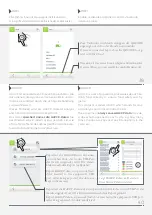
70
Stillstandszeiten
Trennen Sie während der Stillstandszeiten die Strom-
versorgung ab. Schützen Sie die äußeren Stahlteile des
Geräts, indem Sie sie mit einem weichen, frisch mit
Vaseline-Öl getränkten Tuch abwischen. Lassen Sie die
Tür etwas offen, um einen ordnungsgemäßen Luftaus-
tausch zu gewährleisten. Beim Reset, vor Gebrauch:
■
reinigen Sie das Gerät und das Zubehör gründlich;
■
schließen Sie das Gerät wieder an die Stromver-
sorgung an;
■
überprüfen Sie das Gerät.
Außerordentliche Wartung
Die außerordentliche Wartung, wie z.B. der Aus-
tausch einer defekten Komponente, darf
nur von
qualifiziertem, vom hersteller autorisiertem Per
-
sonal durchgeführt werden
. Der Hersteller lehnt
jede Verantwortung ab und erkennt die Garantie
nicht an, wenn der Bediener selbst außerordentliche
Wartungsarbeiten durchführt.
Entsorgung am Ende der
Lebensdauer
Gemäß Art. 13 des Gesetzesdekrets Nr. 49 von 2014
„Umsetzung der WEEE-Richtlinie 2012/19/EU über
Elektro- und Elektronik-Altgeräte“
IT08020000000615
Das Symbol der durchgestrichenen Ab-
falltonne gibt an, dass das Produkt nach
dem 13. August 2015 auf den Markt ge-
bracht wurde und dass es am Ende seiner
Nutzungsdauer nicht als sonstiger Abfall
behandelt, sondern getrennt entsorgt werden muss.
Alle Geräte werden aus wiederverwertbaren Metall-
materialien (Edelstahl, Eisen, Aluminium, verzinktem
Blech, Kupfer usw.) mit einem Anteil von mehr als
90% des Gewichts hergestellt. Machen Sie das Ge-
rät für die Entsorgung unbrauchbar, indem Sie das
Stromkabel und alle Hohlräume oder Hohlraumver-
schlussvorrichtungen (falls vorhanden) entfernen.
Es ist notwendig, der Behandlung dieses Produkts
am Ende seiner Lebensdauer Aufmerksamkeit zu
schenken, die negativen Auswirkungen auf die Um-
welt zu reduzieren und die effizienz der ressour
-
cennutzung zu verbessern, indem die Prinzipien des
„Verursacherprinzips“, der Vorbeugung, der Vorbe-
reitung zur Wiederverwendung, des Recyclings und
der Rückgewinnung angewendet werden. Es wird
darauf hingewiesen, dass die missbräuchliche oder
Periods of inactivity
During periods of inactivity, disconnect the power
supply. Protect the external steel parts of the equip-
ment by wiping them with a soft cloth doused in
Vaseline oil. Leave the door ajar to ensure correct air
exchange. Before using the equipment again:
■
thoroughly clean the equipment and accessories;
■
reconnect the equipment to the power supply;
■
check the equipment.
Non-routine maintenance
Non-routine maintenance, such as replacing a de-
fective component, must
only be performed by
qualified personnel authorised by the manufac
-
turer
. The manufacturer declines all liability and the
warranty is void if the user carries out non-routine
maintenance themselves.
Disposal at end of product
life
Pursuant to art. 13 of Italian Legislative Decree no.
49 of 2014 “Implementation of the WEEE Directive
2012/19/EU on electrical and electronic equipment
waste”
IT08020000000615
The crossed-out wheeled bin symbol in-
dicates that the product was placed on
the market after 13 August 2015 and that,
at the end of its useful life, it must be dis-
posed of separately and not with other
waste.
All the equipment is made of recyclable metal ma-
terials (stainless steel, iron, aluminium, galvanised
sheet metal, copper, etc.) in a percentage greater
than 90% by weight. Make the equipment unusable
for disposal by removing the power cable and any
compartment or cavity closing device (where pres-
ent). At the end of its useful life, the product must be
disposed of in such a way as to reduce any negative
impact on the environment and make efficient use
of available resources. Prefer prevention, preparation
for reuse, recycling and reclamation, and remember
“the polluter pays”. Please remember that illegal or
incorrect disposal of the product incurs penalties, as
provided for by current legislation.
Summary of Contents for nortech 433 Series
Page 1: ...COOKING AND CHILLING A UNIQUE EXPERIENCE Verwendung und Wartung Use and maintenance...
Page 15: ...15...
Page 27: ...27 SONDERZYKLEN SPECIAL CYCLES...
Page 28: ...28 Schnellk hlen und Tiefk hlen blast chilling and shock freezing...
Page 39: ...39 SCHNELLK HLUNG TIEFK HLUNG PERS NLICHE ANMERKUNGEN BLAST CHILLING SHOCK FREEZING NOTES...
Page 42: ...42 AUFTAUEN THAWING...
Page 46: ...46 SONDERZYKLEN SPECIAL CYCLES...
Page 53: ...53 SONDERZYKLEN SPECIAL CYCLES...
Page 56: ...56 Zellen ZYKLEN Zellen ZYKLEN CABINET CYCLES...
Page 60: ...37...
Page 61: ...61...
Page 67: ...67 PERS NLICHE ANMERKUNGEN NOTES...
Page 74: ...74...
Page 75: ...75...







































